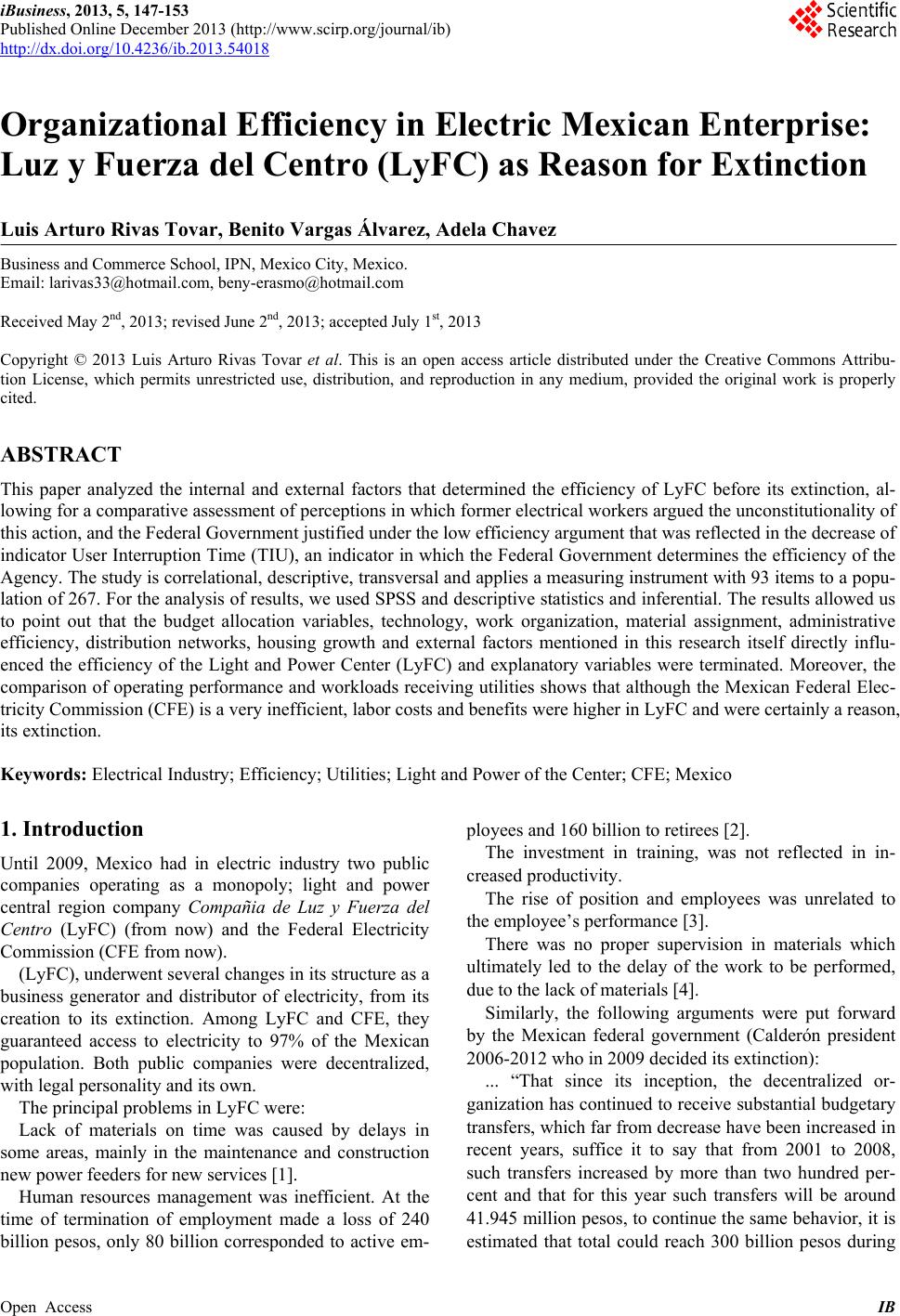 iBusiness, 2013, 5, 147-153 Published Online December 2013 (http://www.scirp.org/journal/ib) http://dx.doi.org/10.4236/ib.2013.54018 Open Access IB 147 Organizational Efficiency in Electric Mexican Enterprise: Luz y Fuerza del Centro (LyFC) as Reason for Extinction Luis Arturo Rivas Tovar, Benito Vargas Álvarez, Adela Chavez Business and Commerce School, IPN, Mexico City, Mexico. Email: larivas33@hotmail.com, beny-erasmo@hotmail.com Received May 2nd, 2013; revised June 2nd, 2013; accepted July 1st, 2013 Copyright © 2013 Luis Arturo Rivas Tovar et al. This is an open access article distributed under the Creative Commons Attribu- tion License, which permits unrestricted use, distribution, and reproduction in any medium, provided the original work is properly cited. ABSTRACT This paper analyzed the internal and external factors that determined the efficiency of LyFC before its extinction, al- lowing for a comparative assessment of perceptions in which former electrical workers argued the unconstitutionality of this action, and the Federal Government justified under the low efficiency argument that was reflected in the decrease of indicator User Interruption Time (TIU), an indicator in which the Federal Government determines the efficiency of the Agency. The study is correlational, descriptive, transversal and applies a measuring instrument with 93 items to a popu- lation of 267. For the analysis of results, we used SPSS and descriptive statistics and inferential. The results allowed us to point out that the budget allocation variables, technology, work organization, material assignment, administrative efficiency, distribution networks, housing growth and external factors mentioned in this research itself directly influ- enced the efficiency of the Light and Power Center (LyFC) and explanatory variables were terminated. Moreover, the comparison of operating performance and workloads receiving utilities shows that although the Mexican Federal Elec- tricity Commission (CFE) is a very inefficient, labor costs and benefits were higher in LyFC and were certainly a reason, its extinction. Keywords: Electrical Industry; Efficiency; Utilities; Light and Power of the Center; CFE; Mexico 1. Introduction Until 2009, Mexico had in electric industry two public companies operating as a monopoly; light and power central region company Compañia de Luz y Fuerza del Centro (LyFC) (from now) and the Federal Electricity Commission (CFE from now). (LyFC), underwent several changes in its structure as a business generator and distributor of electricity, from its creation to its extinction. Among LyFC and CFE, they guaranteed access to electricity to 97% of the Mexican population. Both public companies were decentralized, with legal personality and its own. The principal problems in LyFC were: Lack of materials on time was caused by delays in some areas, mainly in the maintenance and construction new power feeders for new services [1]. Human resources management was inefficient. At the time of termination of employment made a loss of 240 billion pesos, only 80 billion corresponded to active em- ployees and 160 billion to retirees [2]. The investment in training, was not reflected in in- creased productivity. The rise of position and employees was unrelated to the employee’s performance [3]. There was no proper supervision in materials which ultimately led to the delay of the work to be performed, due to the lack of materials [4]. Similarly, the following arguments were put forward by the Mexican federal government (Calderón president 2006-2012 who in 2009 decided its extinction): ... “That since its inception, the decentralized or- ganization has continued to receive substantial budgetary transfers, which far from decrease have been increased in recent years, suffice it to say that from 2001 to 2008, such transfers increased by more than two hundred per- cent and that for this year such transfers will be around 41.945 million pesos, to continue the same behavior, it is estimated that total could reach 300 billion pesos during  Organizational Efficiency in Electric Mexican Enterprise: Luz y Fuerza del Centro (LyFC) as Reason for Extinction 148 the present administration; That costs almost double its sales revenue, from 2003 to 2008 recorded sales revenue of 235.738 million pesos, while its costs were $433.290 million pesos (including electricity purchased from the Federal Electricity Com- mission); 1) The percentage of total energy losses of Luz y Fuerza del Centro is excessive and almost three times higher than the person lodging the Federal Electricity Commission. In June 2009, Luz y Fuerza lost 30.6% of energy, while that Commission lost 10.9%, almost no utility in the world recorded the percentage of losses that presents LyFC. 2) In 2008, Luz y Fuerza lost 32.5% of the energy generated to buy and sell. The estimated value of these total losses amounted to nearly 25 billion pesos, which represents 52% of total sales revenue of the organism, and 3) In the best case, the unit costs of the works executed Luz y Fuerza del Centro is 176% higher than the costs of the Federal Electricity Commission… [5].” The aim of this paper is to analyze the organizational efficiency of LyFC as extinction ratio by benchmarking perception among various employees of the defunct company. It is organized as follows: In brief, it presents the results of international experience in the efficiency of the elec- tricity industry, describes the most outstanding one and briefly mentions the research methodology, and after comparing the operating performance of the company and stating labor versus CFE LyFC, it finally analyzed 8 variables which measure the perception of efficiency. The determinants of efficiency in an electric utility are: allocation of budget, technology, work organization, material assignment, administrative efficiency, distribu- tion networks, housing growth and external factors. 2. The International Context After a decade of openness to investment in the elec- tricity markets in the world, there is clear evidence of its success or failure [6]. There are successful experiences that have been made to increase efficiency, power quality and productivity at the same time it has managed to attract capital and reduce prices. There are also experiences less fortunate, in that the continuity and quality of supply have degraded, or prices have skyrocketed. In some cases, the State, it was out, had to intervene directly to prevent further damage to the national or local economy [7]. The California crisis that began when the energy market was liberalized at the state level in 1996, meant that in the summer of 2001 that the state suffered blackouts of between 20 and 200 hours. With the policy of 1996, in which energy prices were no longer under state control, they began to be governed by the laws of supply and demand. The speculation caused prices to soar and they create serious problems for utility com- panies, which had to pay a lot more for energy generating companies, and could not move the new costs, as the price paid by consumers remained subject to regulation [8]. In Chile the power outages in 2001 strongly bothered business sectors, especially in the trade and the mining industry, for the economic losses caused by the lack of energy. Concern mining sector concerned court implied that each stop producing hundreds of thousands of tons of copper, mostly. Analysts linked the sector indicated, by way of comparison, in the court on July 25 of that year, when the Great Northern was without power for 15 hours, the industry lost about $7 million, which means more than $466 .000 per hour without producing. In Brazil, the current situation of the electricity sector is also critical. The reason s date back to the 1980s, wh en a cross-subsidy system was a strong disincentive to effi- ciency improvements, and budget problems delayed in- vestments. Despite the introduction of new legislation in 1995 aimed at enabling and attracting private capital and the power sector, new investments in generation and transmission that were expected until today have not materialized in the amounts needed. While private com- panies control 80% of the country’s distribution system, few private investors are willi ng to take the risk of build- ing new plants, firstly, because of the uncertainty crea ted by the incomplete implementation of the reform and on the other, as a result of the 1999 financial crisis, which has increased the country’s currency risk. The situation is far from being resolved, since only a few of the fifty or more power stations gas ignition that the government is promoting the Thermoelectric Priority Program can start operating in mid-2002 [9]. 3. State of Art Efficiency, also known as productivity is generally un- derstood as the relationship between the output obtained by a system of production or services and the resources used to obtain, can also be defined as the relationship between the results and the time used to obtain them: the shorter the time it takes to get the desired result, the more productive the system. In the area of professional development, efficiency is the economic index that relates production to the re- sources used for this production, expressed as produc- tion/resources [10]. The term global efficiency is a concept that is used to help improve productivity through the study and discus- sion of the determinants of efficiency and of the elements involved in it [11]. In reviewing the studies on the efficiency in the power Open Access IB 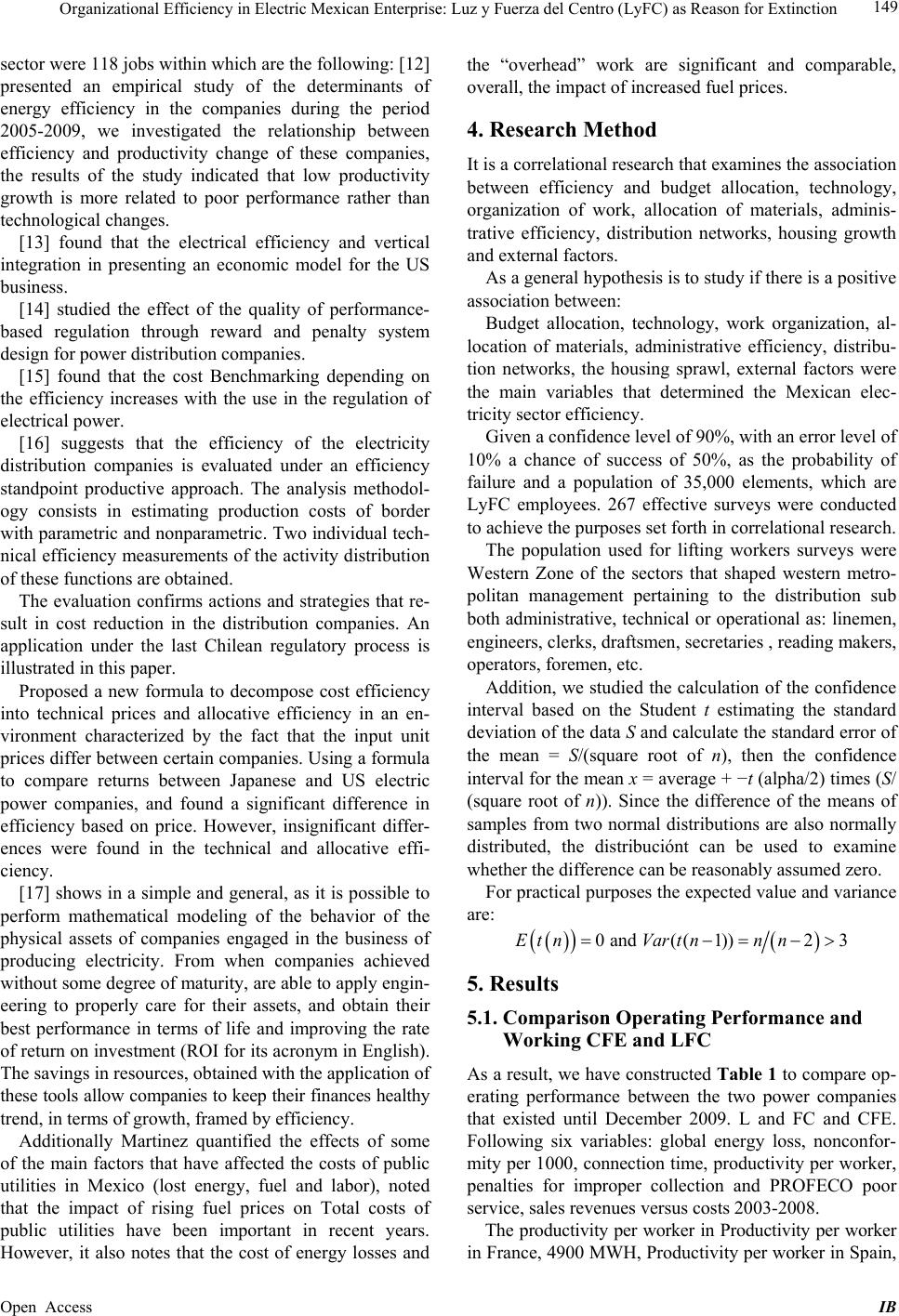 Organizational Efficiency in Electric Mexican Enterprise: Luz y Fuerza del Centro (LyFC) as Reason for Extinction 149 sector were 118 jobs within which are the following: [12] presented an empirical study of the determinants of energy efficiency in the companies during the period 2005-2009, we investigated the relationship between efficiency and productivity change of these companies, the results of the study indicated that low productivity growth is more related to poor performance rather than technological changes. [13] found that the electrical efficiency and vertical integration in presenting an economic model for the US business. [14] studied the effect of the quality of performance- based regulation through reward and penalty system design for power distribution companies. [15] found that the cost Benchmarking depending on the efficiency increases with the use in the regulation of electrical power. [16] suggests that the efficiency of the electricity distribution companies is evaluated under an efficiency standpoint productive approach. The analysis methodol- ogy consists in estimating production costs of border with parametric and nonparametric. Two individual tech- nical efficiency measurements of the activity distribution of these functions are obtained. The evaluation confirms actions and strategies that re- sult in cost reduction in the distribution companies. An application under the last Chilean regulatory process is illustrated in this paper. Proposed a new formula to decompose cost efficiency into technical prices and allocative efficiency in an en- vironment characterized by the fact that the input unit prices differ between certain companies. Using a formula to compare returns between Japanese and US electric power companies, and found a significant difference in efficiency based on price. However, insignificant differ- ences were found in the technical and allocative effi- ciency. [17] shows in a simple and general, as it is possible to perform mathematical modeling of the behavior of the physical assets of companies engaged in the business of producing electricity. From when companies achieved without some degree of maturity, are able to apply engin- eering to properly care for their assets, and obtain their best performance in terms of life and improving the rate of return on investment (ROI for its acronym in English). The savings in resources, obtained with the application of these tools allow companies to keep their finances healthy trend, in terms of growth, framed by efficiency. Additionally Martinez quantified the effects of some of the main factors that have affected the costs of public utilities in Mexico (lost energy, fuel and labor), noted that the impact of rising fuel prices on Total costs of public utilities have been important in recent years. However, it also notes that the cost of energy losses and the “overhead” work are significant and comparable, overall, the impact of increased fuel prices. 4. Research Method It is a correlational research that examines the association between efficiency and budget allocation, technology, organization of work, allocation of materials, adminis- trative efficiency, distribution networks, housing growth and external factors. As a general hypothesis is to study if there is a positive association between: Budget allocation, technology, work organization, al- location of materials, administrative efficiency, distribu- tion networks, the housing sprawl, external factors were the main variables that determined the Mexican elec- tricity sector efficiency. Given a confidence level of 90%, with an error level of 10% a chance of success of 50%, as the probability of failure and a population of 35,000 elements, which are LyFC employees. 267 effective surveys were conducted to achieve the purposes set forth in correlational research. The population used for lifting workers surveys were Western Zone of the sectors that shaped western metro- politan management pertaining to the distribution sub both administrative, technical or operational as: linemen, engineers, clerks, draftsmen, secretaries , reading makers, operators, foremen, etc. Addition, we studied the calculation of the confidence interval based on the Student t estimating the standard deviation of the data S and calculate the standard error of the mean = S/(square root of n), then the confidence interval for the mean x = average + −t (alpha/2) times (S/ (square root of n)). Since the difference of the means of samples from two normal distributions are also normally distributed, the distribuciónt can be used to examine whether the difference can be reasonably assumed zero. For practical purposes the expected value and variance are: 0 and 123(( ))EtnVartnn n 5. Results 5.1. Comparison Operating Performance and Working CFE and LFC As a result, we have constructed Table 1 to compare op- erating performance between the two power companies that existed until December 2009. L and FC and CFE. Following six variables: global energy loss, nonconfor- mity per 1000, connection time, productivity per worker, penalties for improper collection and PROFECO poor service, sales revenues versus costs 2003-2008. The productivity per worker in Productivity per worker in France, 4900 MWH, Productivity per worker in Spain, Open Access IB 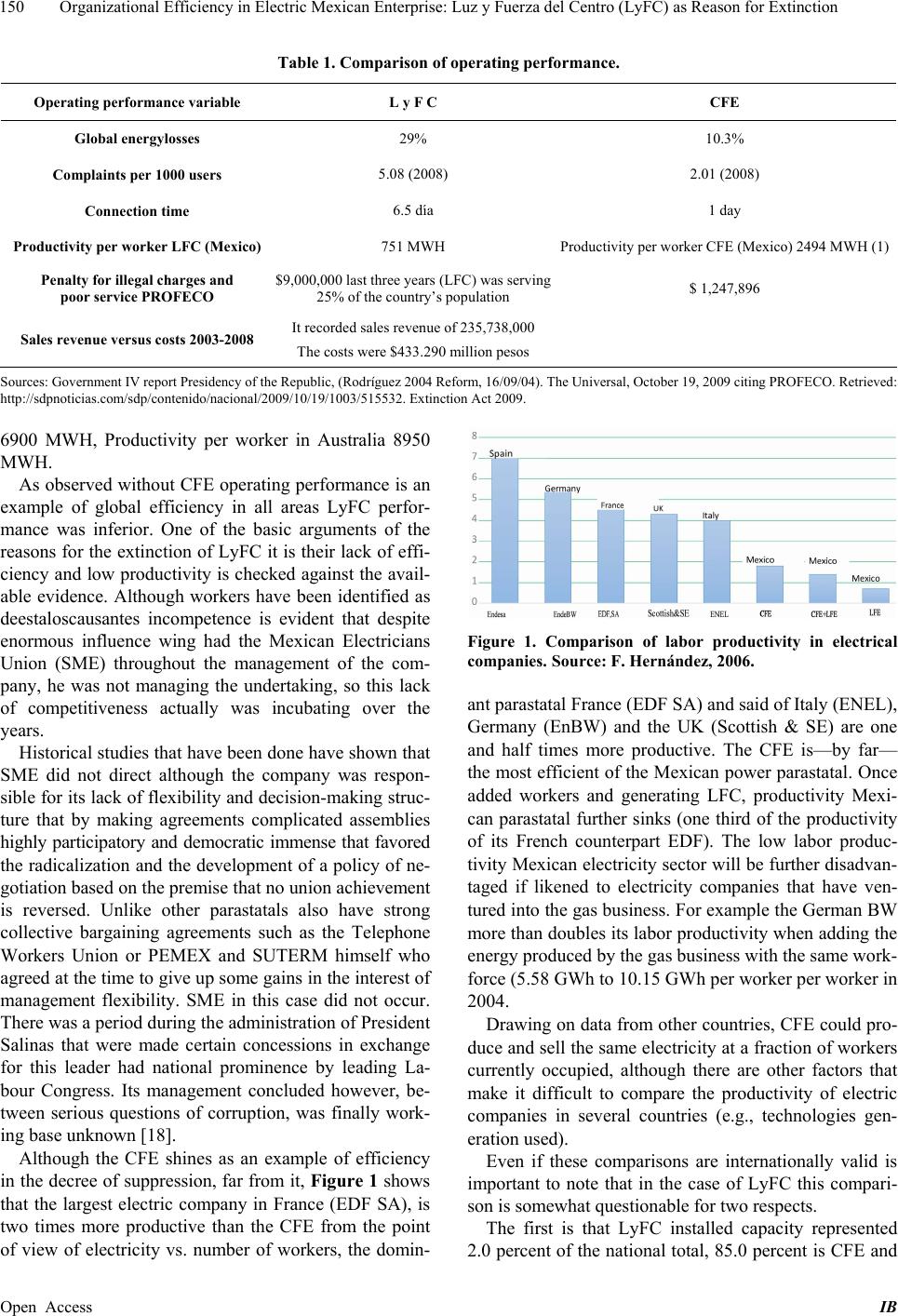 Organizational Efficiency in Electric Mexican Enterprise: Luz y Fuerza del Centro (LyFC) as Reason for Extinction Open Access IB 150 Table 1. Comparison of operating performance. Operating performance variable L y F C CFE Global energylosses 29% 10.3% Complaints per 1000 users 5.08 (2008) 2.01 (2008) Connection time 6.5 día 1 day Productivity per worker LFC (Mexico) 751 MWH Productivity per worker CFE (Mexico) 2494 MWH (1) Penalty for illegal charges and poor service PROFECO $9,000,000 last three years (LFC) was serving 25% of the country’s population $ 1,247,896 Sales revenue versus costs 20 0 3 -2008 It recorded sales revenue of 235,738,000 The costs were $433.290 million pesos Sources: Government IV report Presidency of the Republic, (Rodríguez 2004 Reform, 16/09/04). The Universal, October 19, 2009 citing PROFECO. Retrieved: http://sdpnoticias.com/sdp/contenido/nacional/2009/10/19/1003/515532. Extinction Act 2009. 6900 MWH, Productivity per worker in Australia 8950 MWH. As observed without CFE operating performance is an example of global efficiency in all areas LyFC perfor- mance was inferior. One of the basic arguments of the reasons for the extinction of LyFC it is their lack of effi- ciency and low productivity is checked against the avail- able evidence. Although workers have been identified as deestaloscausantes incompetence is evident that despite enormous influence wing had the Mexican Electricians Union (SME) throughout the management of the com- pany, he was not managing the undertaking, so this lack of competitiveness actually was incubating over the years. Figure 1. Comparison of labor productivity in electrical companies. Source: F. Hernández, 2006. ant parastatal France (EDF SA) and said of Italy (ENEL), Germany (EnBW) and the UK (Scottish & SE) are one and half times more productive. The CFE is—by far— the most efficient of the Mexican power parastatal. Once added workers and generating LFC, productivity Mexi- can parastatal further sinks (one third of the productivity of its French counterpart EDF). The low labor produc- tivity Mexican electricity sector will be further disadvan- taged if likened to electricity companies that have ven- tured into the gas business. For example the German BW more than doubles its labor productivity when adding the energy produced by the gas business with the same work- force (5.58 GWh to 10.15 GWh per worker per worker in 2004. Historical studies that have been done have shown that SME did not direct although the company was respon- sible for its lack of flexibility and decision-making struc- ture that by making agreements complicated assemblies highly participatory and democratic immense that favored the radicalization and the development of a policy of ne- gotiation based on the premise that no union achievement is reversed. Unlike other parastatals also have strong collective bargaining agreements such as the Telephone Workers Union or PEMEX and SUTERM himself who agreed at the time to give up some gains in the interest of management flexibility. SME in this case did not occur. There was a period during the administration of President Salinas that were made certain concessions in exchange for this leader had national prominence by leading La- bour Congress. Its management concluded however, be- tween serious questions of corruption, was finally work- ing base unknown [18]. Drawing on data from other countries, CFE could pro- duce and sell the same electricity at a fraction of workers currently occupied, although there are other factors that make it difficult to compare the productivity of electric companies in several countries (e.g., technologies gen- eration used). Although the CFE shines as an example of efficiency in the decree of suppression, far from it, Figure 1 shows that the largest electric company in France (EDF SA), is two times more productive than the CFE from the point of view of electricity vs. number of workers, the domin- Even if these comparisons are internationally valid is important to note that in the case of LyFC this compari- son is somewhat questionable for two respects. The first is that LyFC installed capacity represented 2.0 percent of the national total, 85.0 percent is CFE and 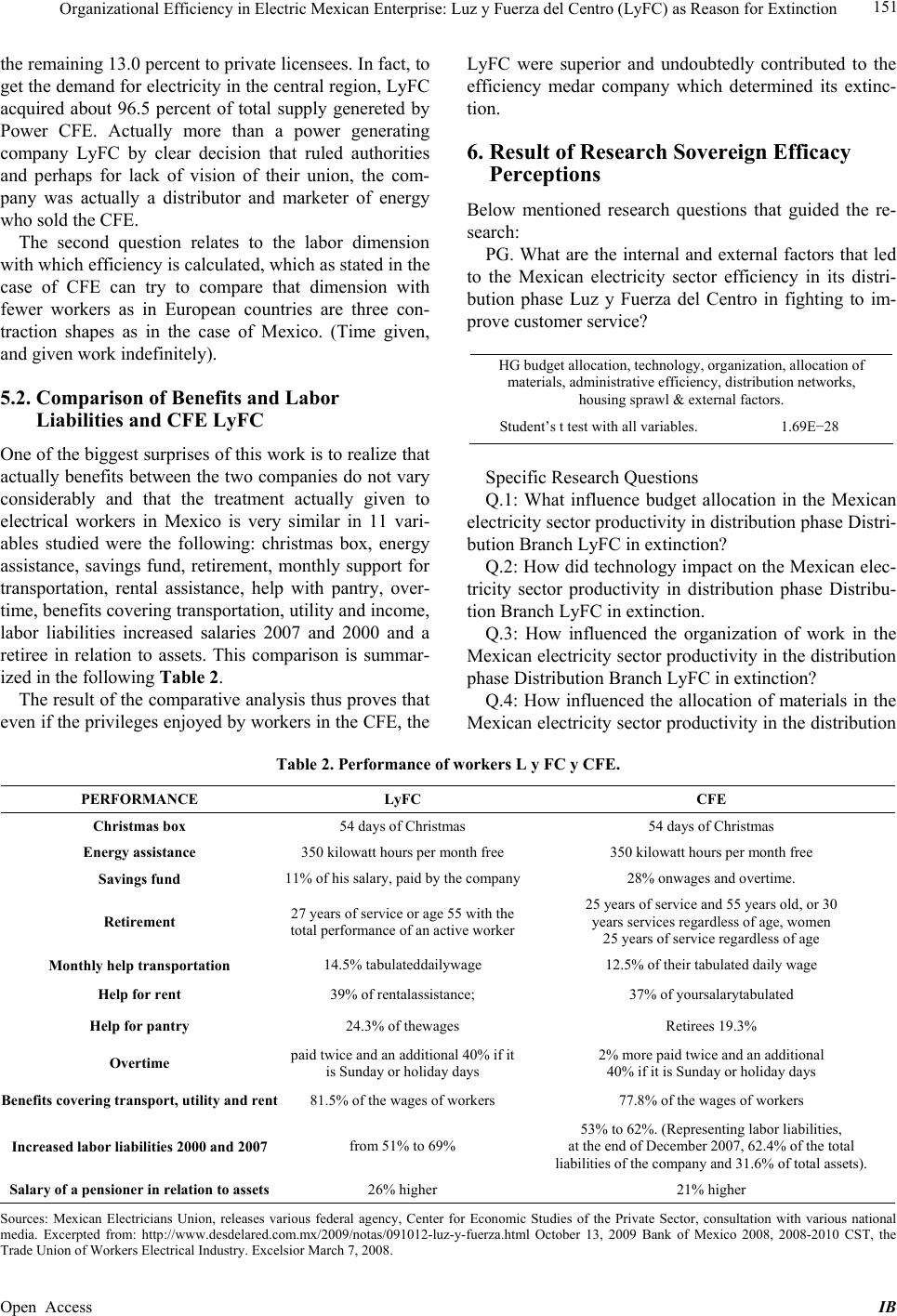 Organizational Efficiency in Electric Mexican Enterprise: Luz y Fuerza del Centro (LyFC) as Reason for Extinction 151 the remaining 13.0 percent to private licensees. In fact, to get the demand for electricity in the central region, LyFC acquired about 96.5 percent of total supply genereted by Power CFE. Actually more than a power generating company LyFC by clear decision that ruled authorities and perhaps for lack of vision of their union, the com- pany was actually a distributor and marketer of energy who sold the CFE. The second question relates to the labor dimension with which efficiency is calculated, which as stated in the case of CFE can try to compare that dimension with fewer workers as in European countries are three con- traction shapes as in the case of Mexico. (Time given, and given work indefinitely). 5.2. Comparison of Benefits and Labor Liabilities and CFE LyFC One of the biggest surprises of this work is to realize that actually benefits between the two companies do not vary considerably and that the treatment actually given to electrical workers in Mexico is very similar in 11 vari- ables studied were the following: christmas box, energy assistance, savings fund, retirement, monthly support for transportation, rental assistance, help with pantry, over- time, benefits covering transportation, utility and income, labor liabilities increased salaries 2007 and 2000 and a retiree in relation to assets. This comparison is summar- ized in the following Table 2. The result of the comparative analysis thus proves that even if the privileges enjoyed by workers in the CFE, the LyFC were superior and undoubtedly contributed to the efficiency medar company which determined its extinc- tion. 6. Result of Research Sovereign Efficacy Perceptions Below mentioned research questions that guided the re- search: PG. What are the internal and external factors that led to the Mexican electricity sector efficiency in its distri- bution phase Luz y Fuerza del Centro in fighting to im- prove customer service? HG budget allocation, technology, organization, allocation of materials, administrative efficiency, distribution networks, housing sprawl & external factors. Student’s t test with all variables. 1.69E−28 Specific Research Questions Q.1: What influence budget allocation in the Mexican electricity sector productivity in distribution phase Distri- bution Branch LyFC in extinction? Q.2: How did technology impact on the Mexican elec- tricity sector productivity in distribution phase Distribu- tion Branch LyFC in extinction. Q.3: How influenced the organization of work in the Mexican electricity sector productivity in the distribution phase Distribution Branch LyFC in extinction? Q.4: How influenced the allocation of materials in the Mexican electricity sector productivity in the distribution Table 2. Performance of workers L y FC y CFE. PERFORMANCE LyFC CFE Christmas box 54 days of Christmas 54 days of Christmas Energy assistance 350 kilowatt hours per month free 350 kilowatt hours per month free Savings fund 11% of his salary, paid by the company28% onwages and overtime. Retirement 27 years of service or age 55 with the total performance of an active worker 25 years of service and 55 years old, or 30 years services regardless of age, women 25 years of service regardless of age Monthly help transportation 14.5% tabulateddailywage 12.5% of their tabulated daily wage Help for rent 39% of rentalassistance; 37% of yoursalarytabulated Help for pantry 24.3% of thewages Retirees 19.3% Overtime paid twice and an additional 40% if it is Sunday or holiday days 2% more paid twice and an additional 40% if it is Sunday or holiday days Benefits covering transport, utility and rent81.5% of the wages of workers 77.8% of the wages of workers Increased labor liabilities 2000 and 2007 from 51% to 69% 53% to 62%. (Representing labor liabilities, at the end of December 2007, 62.4% of the total liabilities of the company and 31.6% of total assets). Salary of a pensioner in relation to assets 26% higher 21% higher Sources: Mexican Electricians Union, releases various federal agency, Center for Economic Studies of the Private Sector, consultation with various national media. Excerpted from: http://www.desdelared.com.mx/2009/notas/091012-luz-y-fuerza.html October 13, 2009 Bank of Mexico 2008, 2008-2010 CST, the rade Union of Workers Electrical Industry. Excelsior March 7, 2008. T Open Access IB 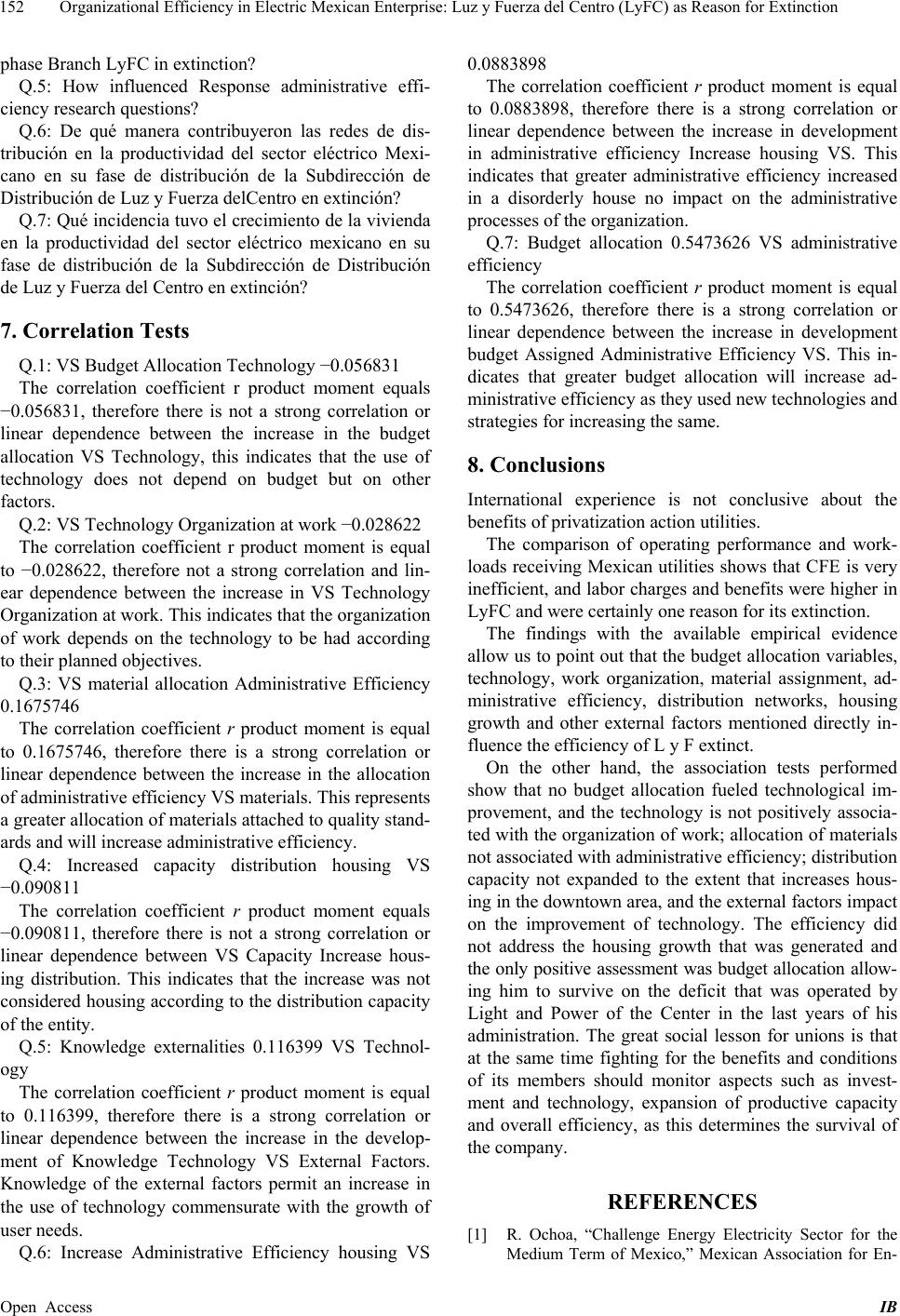 Organizational Efficiency in Electric Mexican Enterprise: Luz y Fuerza del Centro (LyFC) as Reason for Extinction 152 phase Branch LyFC in extinction? Q.5: How influenced Response administrative effi- ciency research questions? Q.6: De qué manera contribuyeron las redes de dis- tribución en la productividad del sector eléctrico Mexi- cano en su fase de distribución de la Subdirección de Distribución de Luz y Fuerza delCentro en extinción? Q.7: Qué incidencia tuvo el crecimiento de la vivienda en la productividad del sector eléctrico mexicano en su fase de distribución de la Subdirección de Distribución de Luz y Fuerza del Centro en extinción? 7. Correlation Tests Q.1: VS Budget Allocation Technology −0.056831 The correlation coefficient r product moment equals −0.056831, therefore there is not a strong correlation or linear dependence between the increase in the budget allocation VS Technology, this indicates that the use of technology does not depend on budget but on other factors. Q.2: VS Technology Organization at work −0.028622 The correlation coefficient r product moment is equal to −0.028622, therefore not a strong correlation and lin- ear dependence between the increase in VS Technology Organization at work. This indicates that the organization of work depends on the technology to be had according to their planned objectives. Q.3: VS material allocation Administrative Efficiency 0.1675746 The correlation coefficient r product moment is equal to 0.1675746, therefore there is a strong correlation or linear dependence between the increase in the allocation of administrative efficiency VS materials. This represents a greater allocation of materials attached to quality stand- ards and will increase administrative efficiency. Q.4: Increased capacity distribution housing VS −0.090811 The correlation coefficient r product moment equals −0.090811, therefore there is not a strong correlation or linear dependence between VS Capacity Increase hous- ing distribution. This indicates that the increase was not considered housing according to the distribution capacity of the entity. Q.5: Knowledge externalities 0.116399 VS Technol- ogy The correlation coefficient r product moment is equal to 0.116399, therefore there is a strong correlation or linear dependence between the increase in the develop- ment of Knowledge Technology VS External Factors. Knowledge of the external factors permit an increase in the use of technology commensurate with the growth of user needs. Q.6: Increase Administrative Efficiency housing VS 0.0883898 The correlation coefficient r product moment is equal to 0.0883898, therefore there is a strong correlation or linear dependence between the increase in development in administrative efficiency Increase housing VS. This indicates that greater administrative efficiency increased in a disorderly house no impact on the administrative processes of the organization. Q.7: Budget allocation 0.5473626 VS administrative efficiency The correlation coefficient r product moment is equal to 0.5473626, therefore there is a strong correlation or linear dependence between the increase in development budget Assigned Administrative Efficiency VS. This in- dicates that greater budget allocation will increase ad- ministrative efficiency as they used new technologies and strategies for increasing the same. 8. Conclusions International experience is not conclusive about the benefits of privatization action utilities. The comparison of operating performance and work- loads receiving Mexican utilities shows that CFE is very inefficient, and labor charges and benefits were higher in LyFC and were certainly one reason for its extinction. The findings with the available empirical evidence allow us to point out that the budget allocation variables, technology, work organization, material assignment, ad- ministrative efficiency, distribution networks, housing growth and other external factors mentioned directly in- fluence the efficiency of L y F extinct. On the other hand, the association tests performed show that no budget allocation fueled technological im- provement, and the technology is not positively associa- ted with the organization of work; allocation of materials not associated with administrative efficiency; distribution capacity not expanded to the extent that increases hous- ing in the downtown area, and the external factors impact on the improvement of technology. The efficiency did not address the housing growth that was generated and the only positive assessment was budget allocation allow- ing him to survive on the deficit that was operated by Light and Power of the Center in the last years of his administration. The great social lesson for unions is that at the same time fighting for the benefits and conditions of its members should monitor aspects such as invest- ment and technology, expansion of productive capacity and overall efficiency, as this determines the survival of the company. REFERENCES [1] R. Ochoa, “Challenge Energy Electricity Sector for the Medium Term of Mexico,” Mexican Association for En- Open Access IB 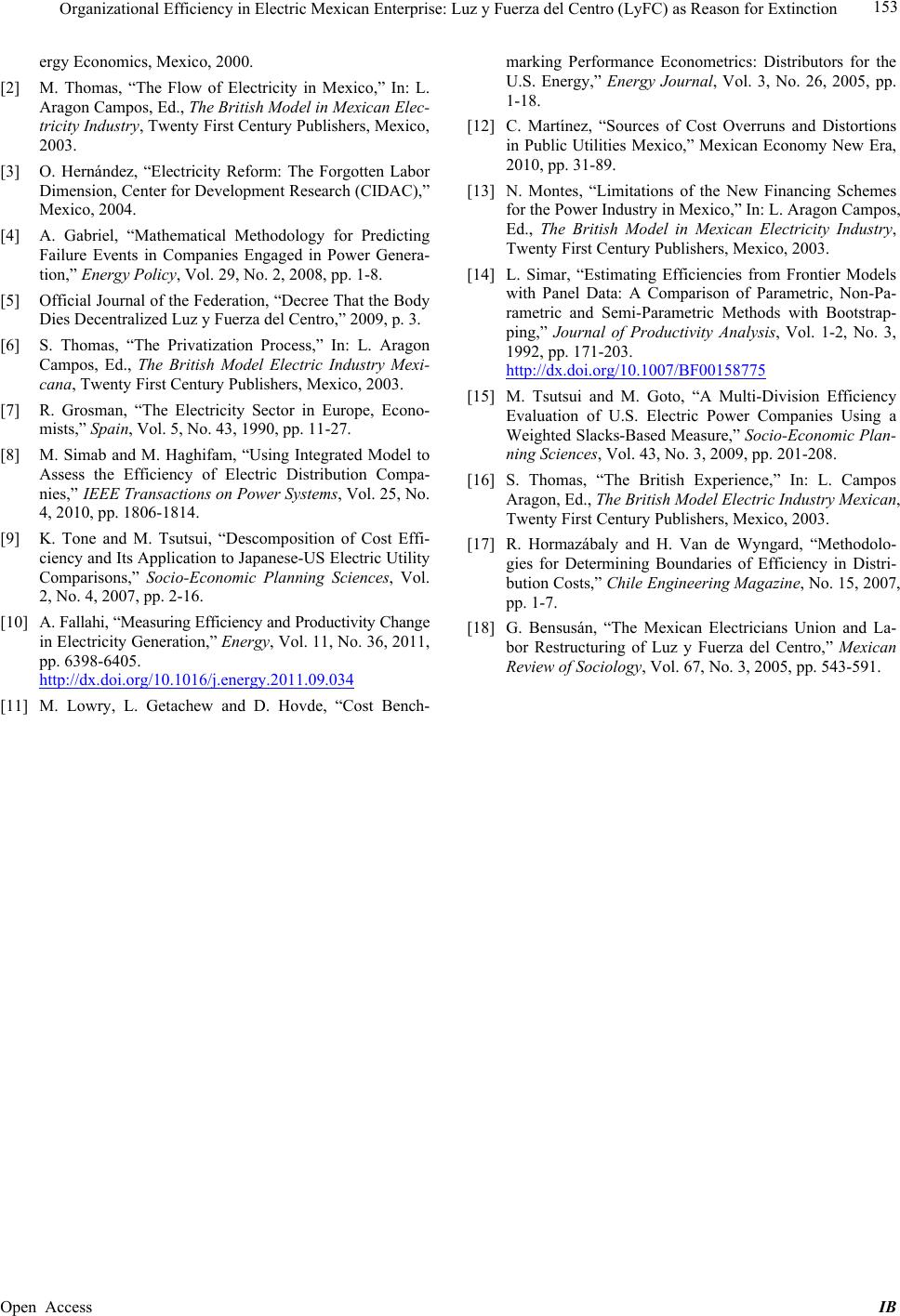 Organizational Efficiency in Electric Mexican Enterprise: Luz y Fuerza del Centro (LyFC) as Reason for Extinction 153 ergy Economics, Mexico, 2000. [2] M. Thomas, “The Flow of Electricity in Mexico,” In: L. Aragon Campos, Ed., The British Model in Mexican Elec- tricity Industry, Twenty First Century Publishers, Mexico, 2003. [3] O. Hernández, “Electricity Reform: The Forgotten Labor Dimension, Center for Development Research (CIDAC),” Mexico, 2004. [4] A. Gabriel, “Mathematical Methodology for Predicting Failure Events in Companies Engaged in Power Genera- tion,” Energy Policy, Vol. 29, No. 2, 2008, pp. 1-8. [5] Official Journal of the Federation, “Decree That the Body Dies Decentralized Luz y Fuerza del Centro,” 2009, p. 3. [6] S. Thomas, “The Privatization Process,” In: L. Aragon Campos, Ed., The British Model Electric Industry Mexi- cana, Twenty First Century Publishers, Mexico, 2003. [7] R. Grosman, “The Electricity Sector in Europe, Econo- mists,” Spain, Vol. 5, No. 43, 1990, pp. 11-27. [8] M. Simab and M. Haghifam, “Using Integrated Model to Assess the Efficiency of Electric Distribution Compa- nies,” IEEE Transactions on Power Systems, Vol. 25, No. 4, 2010, pp. 1806-1814. [9] K. Tone and M. Tsutsui, “Descomposition of Cost Effi- ciency and Its Application to Japanese-US Electric Utility Comparisons,” Socio-Economic Planning Sciences, Vol. 2, No. 4, 2007, pp. 2-16. [10] A. Fallahi, “Measuring Efficiency and Productivity Change in Electricity Generation,” Energy, Vol. 11, No. 36, 2011, pp. 6398-6405. http://dx.doi.org/10.1016/j.energy.2011.09.034 [11] M. Lowry, L. Getachew and D. Hovde, “Cost Bench- marking Performance Econometrics: Distributors for the U.S. Energy,” Energy Journal, Vol. 3, No. 26, 2005, pp. 1-18. [12] C. Martínez, “Sources of Cost Overruns and Distortions in Public Utilities Mexico,” Mexican Economy New Era, 2010, pp. 31-89. [13] N. Montes, “Limitations of the New Financing Schemes for the Power Industry in Mexico,” In: L. Aragon Campos, Ed., The British Model in Mexican Electricity Industry, Twenty First Century Publishers, Mexico, 2003. [14] L. Simar, “Estimating Efficiencies from Frontier Models with Panel Data: A Comparison of Parametric, Non-Pa- rametric and Semi-Parametric Methods with Bootstrap- ping,” Journal of Productivity Analysis, Vol. 1-2, No. 3, 1992, pp. 171-203. http://dx.doi.org/10.1007/BF00158775 [15] M. Tsutsui and M. Goto, “A Multi-Division Efficiency Evaluation of U.S. Electric Power Companies Using a Weighted Slacks-Based Measure,” Socio-Economic Plan- ning Sciences, Vol. 43, No. 3, 2009, pp. 201-208. [16] S. Thomas, “The British Experience,” In: L. Campos Aragon, Ed., The British Model Electric Industry Mexican, Twenty First Century Publishers, Mexico, 2003. [17] R. Hormazábaly and H. Van de Wyngard, “Methodolo- gies for Determining Boundaries of Efficiency in Distri- bution Costs,” Chile Engineering Magazine, No. 15, 2007, pp. 1-7. [18] G. Bensusán, “The Mexican Electricians Union and La- bor Restructuring of Luz y Fuerza del Centro,” Mexican Review of Sociology, Vol. 67, No. 3, 2005, pp. 543-591. Open Access IB
|